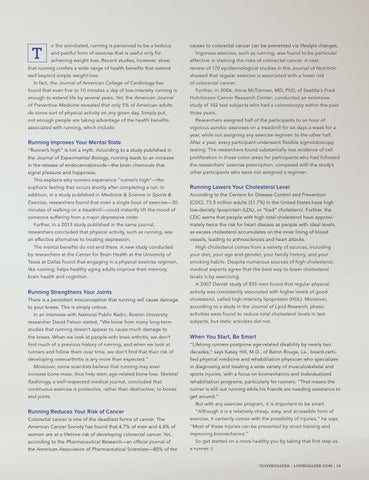o the uninitiated, running is perceived to be a tedious and painful form of exercise that is useful only for achieving weight loss. Recent studies, however, show that running confers a wide range of health benefits that extend well beyond simple weight-loss. In fact, the Journal of American College of Cardiology has found that even five to 10 minutes a day of low-intensity running is enough to extend life by several years. Yet, the American Journal of Preventive Medicine revealed that only 5% of American adults do some sort of physical activity on any given day. Simply put, not enough people are taking advantage of the health benefits associated with running, which include:
T
Running Improves Your Mental State “Runner’s high” is not a myth. According to a study published in the Journal of Experimental Biology, running leads to an increase in the release of endocannabinoids—the brain chemicals that signal pleasure and happiness. This explains why runners experience “runner’s high”—the euphoric feeling that occurs shortly after completing a run. In addition, in a study published in Medicine & Science in Sports & Exercise, researchers found that even a single bout of exercise—30 minutes of walking on a treadmill—could instantly lift the mood of someone suffering from a major depressive order. Further, in a 2013 study published in the same journal, researchers concluded that physical activity, such as running, was an effective alternative to treating depression. The mental benefits do not end there. A new study conducted by researchers at the Center for Brain Health at the University of Texas at Dallas found that engaging in a physical exercise regimen, like running, helps healthy aging adults improve their memory, brain health and cognition.
Running Strengthens Your Joints There is a persistent misconception that running will cause damage to your knees. This is simply untrue. In an interview with National Public Radio, Boston University researcher David Felson stated, “We know from many long-term studies that running doesn’t appear to cause much damage to the knees. When we look at people with knee arthritis, we don’t find much of a previous history of running, and when we look at runners and follow them over time, we don’t find that their risk of developing osteoarthritis is any more than expected.” Moreover, some scientists believe that running may even increase bone mass, thus help stem age-related bone loss. Skeletal Radiology, a well-respected medical journal, concluded that continuous exercise is protective, rather than destructive, to bones and joints.
Running Reduces Your Risk of Cancer Colorectal cancer is one of the deadliest forms of cancer. The American Cancer Society has found that 4.7% of men and 4.4% of women are at a lifetime risk of developing colorectal cancer. Yet, according to the Pharmaceutical Research—an official journal of the American Association of Pharmaceutical Scientists—80% of the
causes to colorectal cancer can be prevented via lifestyle changes. Vigorous exercise, such as running, was found to be particular effective in slashing the risks of colorectal cancer. A vast review of 170 epidemiological studies in the Journal of Nutrition showed that regular exercise is associated with a lower risk of colorectal cancer. Further, in 2006, Anne McTiernan, MD, PhD, of Seattle’s Fred Hutchinson Cancer Research Center, conducted an extensive study of 102 test subjects who had a colonoscopy within the past three years. Researchers assigned half of the participants to an hour of vigorous aerobic exercises on a treadmill for six days a week for a year, while not assigning any exercise regimen to the other half. After a year, every participant underwent flexible sigmoidoscopy testing. The researchers found substantially less evidence of cell proliferation in those colon areas for participants who had followed the researchers’ exercise prescription, compared with the study’s other participants who were not assigned a regimen.
Running Lowers Your Cholesterol Level According to the Centers for Disease Control and Prevention (CDC), 73.5 million adults (31.7%) in the United States have high low-density lipoprotein (LDL), or “bad” cholesterol. Further, the CDC warns that people with high total cholesterol have approximately twice the risk for heart disease as people with ideal levels, as excess cholesterol accumulates on the inner lining of blood vessels, leading to arthrosclerosis and heart attacks. High cholesterol comes from a variety of sources, including your diet, your age and gender, your family history, and your smoking habits. Despite numerous sources of high cholesterol, medical experts agree that the best way to lower cholesterol levels is by exercising. A 2007 Danish study of 835 men found that regular physical activity was consistently associated with higher levels of good cholesterol, called high-intensity lipoprotein (HDL). Moreover, according to a study in the Journal of Lipid Research, phasic activities were found to reduce total cholesterol levels in test subjects, but static activities did not.
When You Start, Be Smart “Lifelong runners postpone age-related disability by nearly two decades,” says Kasey Hill, M.D., of Baton Rouge, La., board-certified physical medicine and rehabilitation physician who specializes in diagnosing and treating a wide variety of musculoskeletal and sports injuries, with a focus on biomechanics and individualized rehabilitation programs, particularly for runners. “That means the runner is still out running while his friends are needing assistance to get around.” But with any exercise program, it is important to be smart. “Although it is a relatively cheap, easy, and accessible form of exercise, it certainly comes with the possibility of injuries,” he says. “Most of these injuries can be prevented by smart training and improving biomechanics.” So get started on a more healthy you by taking that first step as a runner. @LIVINGSAFER / LIVINGSAFER.COM / 19
